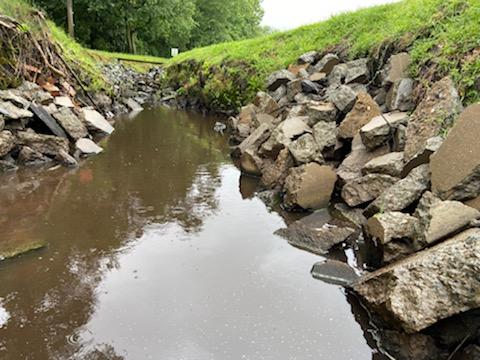Two Inches Of Rain Was All It Took
By: Kemp Burdette

Two inches of rain was all it took to send three million gallons of hog feces and urine coursing from Sampson County’s B&L Farms to Starlins Swamp, a mile away.
Two inches of rain was all it took to kill at least 1,000 fish, including brim, catfish, bass, and at least one eel.
This is worrisome, because the number of days with three or more inches of rain has been historically high in the Southeast over the past 25 years. Consider that Hurricane Florence soaked Duplin and Sampson counties, the epicenter of hog production in North Carolina, with more than 20 inches of rain.
North Carolina’s swine industry likes to say it’s one of the most heavily regulated industries in the state. In practice, though, what regulation there is relies almost entirely on self-reporting. The June 12 spill at B&L is only the latest example of that self-reporting falling short.
There’s a lot to keep track of. The hog waste from Sampson, Duplin, and Robeson counties alone could fill 6,715 Olympic-sized swimming pools. There are 3,804 pits full of hog waste dug into the porous soil of our coastal plain.
These earthen pits are a primitive — and cheap — way to store massive amounts of waste. Most pits can hold about 3 million gallons of waste, making them an ever-present environmental threat.
Hog operations and their waste pits, are supposed to be inspected by the state only once a year. The inspections aren’t a surprise; instead, they’re usually announced more than a week in advance. Imagine what the roads might look like if traffic police only monitored speeding on the interstate once a year — and published in advance what day that would be.
Inspections last a little more than an hour; last year, 100 swine operations went uninspected.
Still, it’s not hard to see why annual inspections are so cursory — and may not happen at all at some operations.
While there are over 2,000 swine operations in eastern North Carolina, the Department of Environmental Quality’s budget has been slashed by more than 40 percent in the last decade. That means fewer inspectors, and a higher caseload for each one.
That, in turn, means a greater reliance than ever on asking the people who run hog operations to monitor themselves.
For instance, permits for hog operations spell out how high the waste in each waste pit can reach. Operators can’t fill the waste pit to the brim, which would threaten a pit’s structural integrity and increase the chance it might overflow when it rains. Hog operators are required to notify the Department of Environmental Quality whenever the waste in a lagoon is higher than the permit allows. But an inspection at B&L after the spill showed the waste had exceeded its permitted waste level, and done so for so long that plants along the berm had died. Still, B&L hadn’t filed the required notice.
The inspection also found that the gauge measuring the waste in the lagoon was installed incorrectly. The top of the lagoon marker was actually 5.04 inches higher than to the lowest point on the remaining lagoon berm. This was a spill waiting to happen. A diligent inspection might have revealed that.
While investigating the spill, Division of Water Resources staff asked to see records from Bryan McLamb, who owns B&L Farms. McLamb was only able to provide a calendar in which he had written down information related to irrigation on April 18, May 2, May 30, and June 6, 2020. The only information documented were hydrant numbers and total hours pumped, DWR reported.
He failed to meet other requirements. He didn’t document the start and stop time of each time waste had been sprayed; he didn’t document the weather code; and he had no documents of the inspections the operation was required to conduct at least every 120 minutes when waste is being sprayed onto cropland. All that documentation is required; all of it was ignored.
These are the types of abuses no one ever sees — until there are three million tons of hog waste in our public trust waterways. It’s time we beefed up the state’s environmental regulators. And it’s time we stopped trusting the swine industry to police itself.
*Photo: The waters sampled by Cape Fear Riverkeeper after the spill. Courtesy of Cape Fear River Watch.